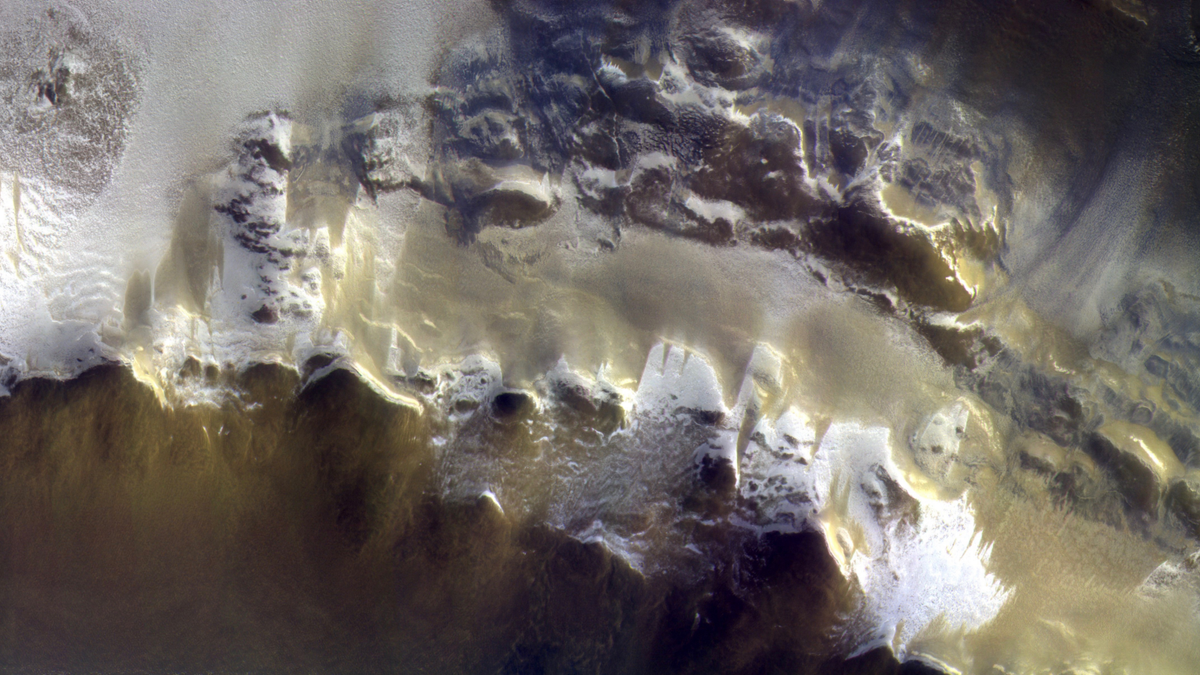
A portion of the first image captured by the Trace Gas Orbiter from its new science orbit, on April 15, 2018. This view shows a stretch of Korolev Crater, in the Red Planet's far north. (ESA/Roscosmos/CaSSIS)
A European Mars spacecraft's first photo from its new orbit is a real doozy.
A few weeks ago, the Trace Gas Orbiter (TGO) slid into a nearly circular path at an altitude about 250 miles (400 kilometers) above the Red Planet's surface. And we've now seen the first image from this perch: a gorgeous photo showing a 25-mile-long (40 km) stretch of the ice-rimed Korolev Crater, in the Martian far north.
TGO snapped the photo on April 15, during the testing phase of its Color and Stereo Surface Imaging System (CaSSIS) camera, European Space Agency (ESA) officials said. CaSSIS is scheduled to begin its bona fide science work on Saturday (April 28). [Photos: Europe's ExoMars Missions to Mars in Pictures]
"We are excited to finally be starting collecting data at Mars with this phenomenal spacecraft," Håkan Svedhem, ESA's TGO project scientist, said in a statement. "The test images we have seen so far certainly set the bar high."
More From Space.com
TGO is part of the ExoMars program, a project led by ESA with assistance from the Russian federal space agency. The orbiter launched in March 2016 along with a landing demonstrator named Schiaparelli, which was designed to test out tech needed for the ExoMars rover. That rover is scheduled to lift off in 2020.
TGO and Schiaparelli arrived at Mars in October 2016; TGO achieved its initial orbit as planned, but the lander crashed on the Red Planet's surface.
Soon after that, TGO embarked upon a yearlong "aerobraking" campaign, during which it used dives through the thin Martian atmosphere to sculpt its orbit. This phase ended in February 2018, and the probe reached its 250-mile-high science orbit shortly thereafter.
TGO's main job involves sniffing for methane and other low-abundance (or trace) gases in the Martian atmosphere, which it began doing using its two onboard spectrometers on April 21. Methane is a possible sign of life; most of the methane in Earth's air is generated by microbes and other organisms. But the stuff can also be produced by geological processes. TGO's observations could help researchers better understand where, and how, Mars methane is being generated, ExoMars team members have said.
CaSSIS' photos will contribute to this work, by pinpointing the locations of possible geological methane sources (such as volcanoes). The cameras' images will also help mission team members decide where to land the rover in 2021, ESA officials said.
TGO also carries one other science instrument, a neutron detector that will allow the probe to map out deposits of buried water ice.
Originally published on Space.com.
